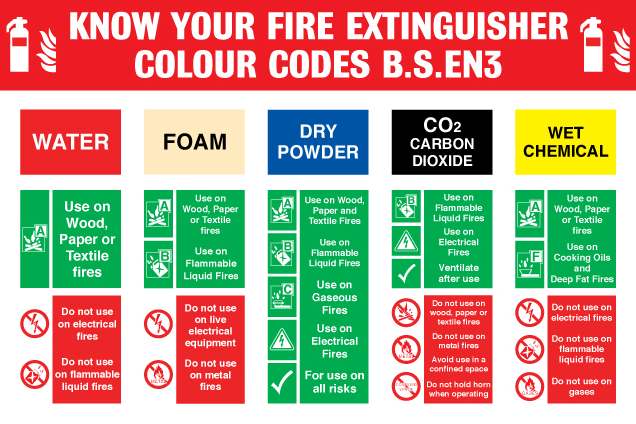
To afford compliance with the Regulatory Reform (Fire Safety) Order 2005, the responsible person must ensure that the premises is equipped with appropriate fire-fighting equipment, where necessary, in order to safeguard the safety of relevant persons. The responsible person must ensure that any non-automatic fire-fighting equipment so provided is easily accessible, simple to use and indicated by signs.
The responsible person must, where necessary:
- take measures for fire-fighting in the premises, adapted to the nature of the activities carried on there and the size of the undertaking and;
- nominate competent persons to implement those measures and ensure that the number of such persons, their training and the equipment available to them are adequate, taking into account the size of and the specific hazards involved in the premises concerned.
Classification of extinguishers
Fires are classed according to what is burning and so the fire extinguishers provided should be appropriate to the classes of fire found in your premises.
No single type of extinguisher is totally effective on every kind of fire. So before buying a fire extinguisher, it is vital to look carefully at what type of fire it has to be used on.
Class of fire – description:
Class A – Fires involving solid materials such as wood, paper or textiles.
Class B – Fires involving flammable liquids such as petrol, diesel or oils.
Class C – Fires involving gases.
Class D – Fires involving metals.
Class F – Fires involving cooking oils such as in deep-fat fryers.
If there is a possibility of a fire in your premises involving material in Class C or D, then you should seek advice from a competent person.
It is not safe to fight fires involving aerosols with fire extinguishers.
Strengths and weaknesses
Water fire extinguishers
Water Fire Extinguishers are good for tackling fires involving burning paper, wood and soft furnishing (Class A fires), as the water soaks into the materials and cools them. This type of extinguisher does not contain harmful chemicals but has a low fire-fighting rating and therefore water fire extinguishers are usually large and heavy to overcome their lack in fire-fighting power. It is also important to remember that water conducts electricity so care must be taken with regards to accidental use on exposed power cables. Water extinguishers with additives have a higher fire-fighting rating which, therefore, allows the use of smaller and lighter extinguishers.
Foam fire extinguishers
Foam fire extinguishers, also called AFFF FOAM (Aqueous Film Forming Foam) are also suitable for use on Class A fires and fires involving flammable liquids (Class B), as the foam creates a smothering film over the fire, starving the fire of oxygen and cooling the liquid.
CO2 (carbon dioxide) fire extinguishers
CO2 (carbon dioxide) fire extinguishers contain pressurised CO2 gas and are suitable for use on fires involving flammable liquids and is also a good solution for tackling fires involving computer equipment and other electrical appliances. It is important to remember that when using CO2 extinguishers there is a possibility that, once the smothering CO2 gas has dissipated, the fire may re-ignite if the materials are still hot.
Dry powder fire extinguishers
Dry Powder Fire Extinguishers are suitable for fighting class A, B and C fires, but the powder does not soak into materials and does not have a good cooling effect on the fire. This can result in the fire re-igniting if it is not properly extinguished. Care must be taken when using powder extinguishers that you do not inhale the powder and the clean up after discharging a powder extinguisher is difficult.
Wet chemical fire extinguishers
Wet Chemical Fire Extinguishers are especially designed for use on kitchen fires involving burning oil and deep fat fryers (Class F fires). The chemical bonds with the burning fat/oil starving the fire of oxygen and cooling the fat/oil.